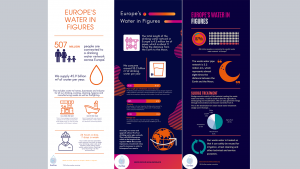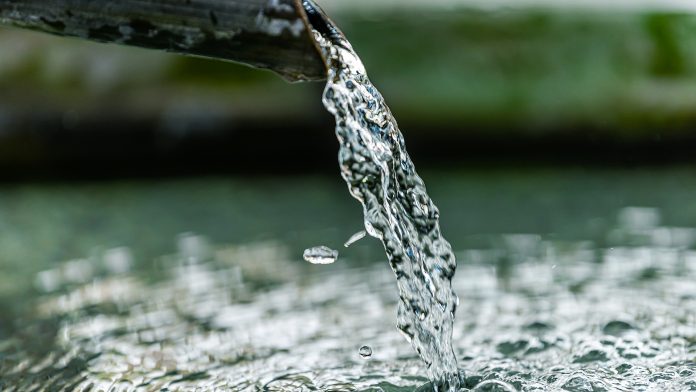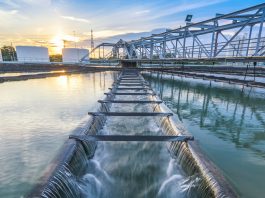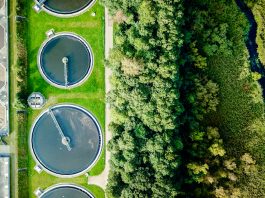Bertrand Vallet, Senior Policy Officer at EurEau, outlines the key findings from the organisation’s latest report examining the drinking and waste water sectors in Europe.
EurEau is the European Federation of National Associations of Water Services, representing national drinking and waste water providers from both the private and public sectors. As an organisation, EurEau supports it members to continually supply clean water and ensure its safe return into the water cycle. It also works to identify and raise awareness of any threats to the water environment.
In July 2021, EurEau released the Europe’s Water in Figures Report, providing an overview of the European drinking water and waste water sectors. The comprehensive survey includes national technical, economic and managerial data ranging from population connection rates, drinking water production and waste water treatment levels to prices and governance. As well as showcasing the diversity of the sector, the report also highlights some of the immediate challenges facing the industry and water infrastructure.
To find out more on the details of the report and what this says of Europe’s water infrastructure, Innovation News Network spoke to EurEau’s Senior Policy Officer, Bertrand Vallet, who compiled the report.
Can you explain more about EurEau as an organisation and the work it does?
We are the European Federation of Water Services and we represent drinking water and waste water providers from both public and private management sectors, with 34 national association members coming from 29 countries. EurEau provides a platform for our members to share their issues and concerns with their peers. We help them to define positions towards the European institutions.
We work closely with our members, stakeholders and policymakers to help shape legislation that robustly protects both consumers and the environment.
How and why was the latest Europe’s Water in Figures Report compiled and what are the main takeaways?
These reports are an attempt to determine what the water infrastructure in Europe are, based on the existing data collected by our members. Our objective with these reports is to make them usable for the European institutions, as we know they are interested in the data we have.
This report is our third edition – following reports released in 2008 and 2017. Compiling the report is an extensive and thorough process using a combination of data collected by us and sent in from our members. We then check that there are no inconsistencies in the data and use linear models to try to tabulate missing data and to estimate what the extrapolated European data is.

If we look at the key findings, there are several things to note. The first point to consider is that it does not make sense to compare one country to another. The contexts are different, and the management systems are different. Each country is unique. We have a tendency to compare on certain parameters, such as the price of water in different countries. However, even these values are difficult to compare, due to such variances as, for example, environmental taxes in some countries but not in others.
We have experienced a positive evolution of the sector, so our income is growing. The connection rates to our infrastructure are also improving, meaning that more people are connected to drinking water networks and to wastewater treatment plants.
The fact that the income is increasing allows us to also reinvest more in the infrastructure, even if the average investment estimation is still 41% of the income. However, what we currently have is not enough. We need to have affordable water and the water price is very political. We are not setting the price for water, but we are the ones that are supposed to invest the money collected, which creates a distortion between the needs and the income. So, there is a need for alignment on this.
We are a growing sector, which generates a significant number of jobs. We have 470,000 direct jobs which, looking at the data, is around 2% of total employment in Europe. The water infrastructure is a stable provider of local employment but, for the first time, we also published the wages of the sector compared to other industries and we can see that the water sector is fairly average in the main. However, there are some discrepancies between rates in some countries – some have have lower than average rates, whereas some are higher than the average. The lowest rates are an issue, because this can cause difficulty in attracting enough competent people to the profession. We hope to see this change in the future.
Another key finding to address is that of sewage sludge on the waste water service side. When we look at the sewage sludge, we can see a slight change between the 2017 report and this one, in terms of the different outputs for sludge and the different ways of treating it. This probably also correlates with national regulations that try to move towards the incineration and recovery of sludge. This, for us, is not a good sign as it translates to a failure in the control at source principle. We do not want to incinerate all of the sludge due to CO2 emissions. Also, we have some countries where the soil needs a lot of organic matter and sludge serves as a good source for these countries. To finish on the positive side, we have also seen a reduction of sludge to landfill.
We have a new section on the circular economy and greenhouse gas emissions in this report, so it connects to the European Green Deal. This report presents energy data for drinking water and for waste water on collection, treatment, energy consumption, and also energy recovery. There is also some data on greenhouse gas emissions but these data are very sparse. We hope that, in the future, people will collect more data and we will be able to evaluate this is in greater detail.
How has the pandemic affected waste water infrastructure?
The COVID-19 pandemic did not really have an effect, because our members managed to mobilise their workforce to continue to operate. Initially, we had a fear that services would be disrupted due to border closures, but our members were able to supply workers to provide for the continuity of the service. We also worked with the European Union to make sure that the chemical supply was continuously provided to our members and that they could have priority.
There are also positive things that have emerged from the pandemic, such as surveillance systems. When you develop COVID-19, or when you are infected with the virus, it goes to your gut and then you excrete it in your waste water. This makes it possible to monitor the evolution of the pandemic by looking at the presence of SARS-CoV-2 in the sewers. There have been recommendations from the European Commission to its member states to look at how they can implement this to monitor the presence of COVID-19 without having to look at individual tests and to allow for a large population to be surveyed. As the operator, we can only provide the water and make samples, but this is not something that we can do analytically. Also, it is not covered by the water bill, so we would need to have specific financing instruments through the health authorities to look at these aspects in a more extensive or systematic way.
What are the key challenges facing the water sector and what can be done to mitigate these?
The major challenge that drives our work is the protection of the water resource. It starts with good implementation of the REACH legislation regarding the authorisation of chemical substances. If we can control the substances and avoid having persistent toxics in them that can then reach the market, we will be able to better protect the resource.
We need to also avoid allowing industrial sites to be connected to sewers and discharge polluting substances that cannot be treated at the waste water treatment plants. If we cannot avoid it, they have to pre-treat their effluent. Without pre-treatments, you are left with two problems once the wastewater has reached the shore. The first is that, if you have a combined sewer, you may reject polluting substances directly to the environment during heavy rains through the combined sewer overflows. The second issue is that you will contaminate the sludge, limiting the capacity of what you can do with it. We have a framework to define the quality of the sludge that can be used in agriculture and we saw that this sludge directive had a positive effect on the control at source of what is discharged in sewers. If we control what is entering the sewer, then we can control the quality of the sludge and what we can do with it.
Not only is this important for the sludge, but it can also lead to a better quality of substances that are recovered, increasing the trust of people using these materials. As we do not currently have markets for these materials, we are looking for legislative solutions and financial supports for this. If the quality is good, then we hope that the market for secondary raw material will be interested by the material that we can recover from waste water treatment streams. All this starts with a control of pollution at the source.
The main difficulties we have in terms of control relate to issues surrounding pollution from agriculture. So here, the European Green Deal is a good instrument and the Farm to Fork strategy that is embedded in the Green Deal is good, because it introduced for the first time a conditionality that meant the farmer would receive funding if they comply with certain environmental requirements. This will help to protect the water infrastructure from pesticides and from nutrients that are migrating to groundwater and surface water.
If we manage to do this, we will be able to rely on water resources of better quality and to have less dependency on by-treatments, which will allow us to have more affordable water services, and will not require so much investment. If the water services are affordable, then you can increase the access to drinking water and sanitation for the poorest populations in Europe.
Bertrand Vallet
Senior Policy Officer
EurEau
www.eureau.org
https://www.linkedin.com/company/eureau-european-federation-of-national-associations-of-water-and-wastewater-services/
https://www.facebook.com/EurEau/
https://twitter.com/eureau
Please note, this article will also appear in the eighth edition of our quarterly publication.





